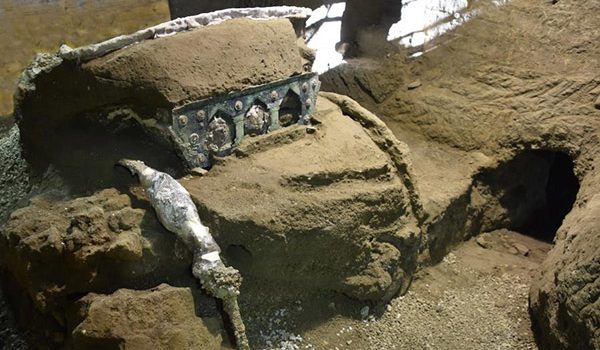THE FOUR-WHEELED PROCESSIONAL CHARIOT. THE LATEST DISCOVERY OF POMPEII
THE ARCHAEOLOGICAL PARK AND THE PUBLIC PROSECUTOR’S OFFICE OF TORRE ANNUNZIATA
announce the discovery of AN EXTRAORDINARY FIND, WHICH HAS EMERGED INTACT FROM THE CIVITA GIULIANA EXCAVATION
THE FOUR-WHEELED PROCESSIONAL CHARIOT
The Archaeological Park of Pompeii and the Public Prosecutor’s Office of Torre Annunziata announce the discovery of an extraordinary find, which has emerged intact from the excavation of the suburban villa of Civita Giuliana, beyond the walls to the north of the ancient city of Pompeii, as part of the joint operations launched in 2017 and in accordance with the Memorandum of Understanding signed in 2019, which sought to combat illegal activities which had been conducted in the area.
A large ceremonial chariot with four wheels, along with its iron components, beautiful bronze and tin decorations, mineralised wood remains and imprints of organic materials (from the ropes to the remains of floral decoration), has been discovered almost intact in the portico facing the stable where, in 2018, the remains of 3 equidae, including a horse still in its harness, had already been found.
This is an exceptional discovery, not only because it adds an additional element to the history of this dwelling and the story of the last moments in the lives of those who lived in it, as well as more generally to our understanding of the ancient world, but above all because it represents a unique find - which has no parallel in Italy thus far - in an excellent state of preservation.
The ongoing excavation project has a dual objective: firstly, to cooperate with the investigations of the Public Prosecutor’s Office of Torre Annunziata, in order to bring an end to the looting of cultural heritage by perpetrators who had dug several tunnels in the area in order to intercept archaeological treasures, and secondly, to reveal one of the most significant villas of the Vesuvian area and to protect it from further looting.
The excavations, which have also allowed us to verify the extent of the illegal tunnels and the damage they have inflicted on cultural heritage, have been constantly accompanied by stabilisation and restoration operations on what has steadily emerged. Indeed, from the start, the excavation has been characterised by considerable technical-operational complexity, since the rooms to be studied are partially below and alongside modern dwellings, with all of the consequent structural and logistical difficulties such a situation entails.
THE EXCAVATION
The interventions which have been carried out over recent months have required careful planning on the part of an interdisciplinary team composed of archaeologists, architects, engineers, restorers, vulcanologists and specialised workers but also, as the excavation proceeded, archaeobotanists and anthropologists. An excavation was subsequently carried out which reached a depth of 6 metres relative to the road level, with stabilisation both of the excavation fronts and the robust masonry structures - which were preserved up to a level of 4 metres - that emerged over the course of the investigations.
From the very beginning, the excavation of the room where the chariot was found revealed its exceptional nature: the area in question is in fact a double-level portico which opens onto an uncovered courtyard, and which features the carbonised wooden ceiling with its network of beams, preserved in its entirety.
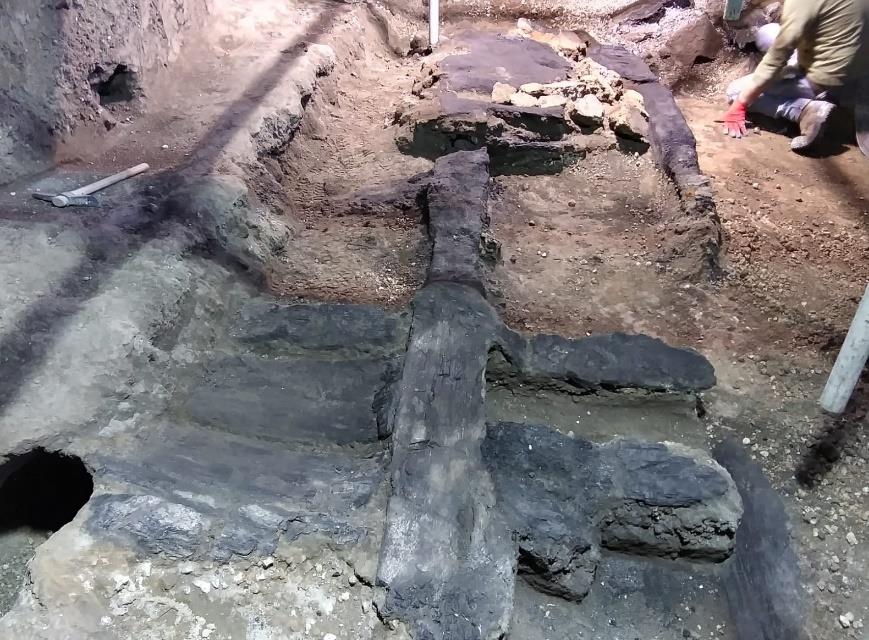
In keeping with the interdisciplinary perspective consistently adopted in the excavations of the Archaeological Park of Pompeii, archaeobotanical analyses have been carried out on the wood, which have shown that the ceiling was constructed of deciduous oak wood (Quercus sp. – cf. robur - English oak), a timber which was frequently used in the Roman age for structural elements. The carbonised wooden structure of the door on the southern side of the room, which connected the portico to the stable where the three equids were recently discovered, was also preserved, and upon analysis was identified as beechwood.
The wooden ceiling was carefully consolidated, cleaned, and removed from the excavation area in order to permit the investigations to continue.
On January 7th an iron artefact, the shape of which suggested the presence of a significant buried artefact, emerged from the covering of volcanic material which had flooded into the portico, just below the removed wooden ceiling.
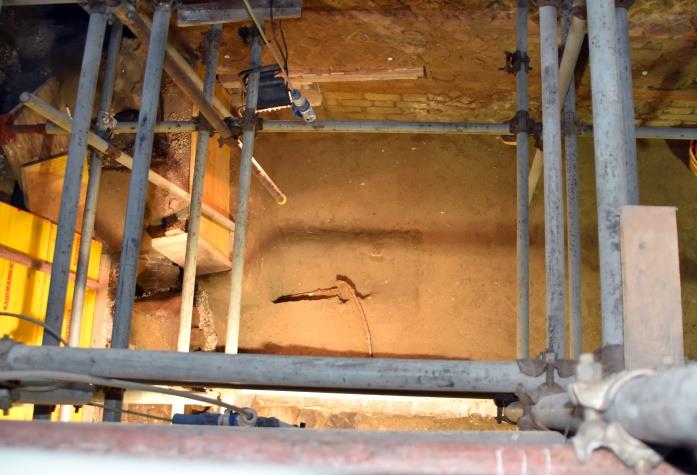
The excavation, which proceeded slowly over the following weeks due to the fragility of the elements which were progressively emerging, unearthed a ceremonial chariot, which had miraculously been spared by both the collapse of the walls and ceiling of the room and by the illegal activities, with tunnels passing it by on two sides, but without compromising the structure.
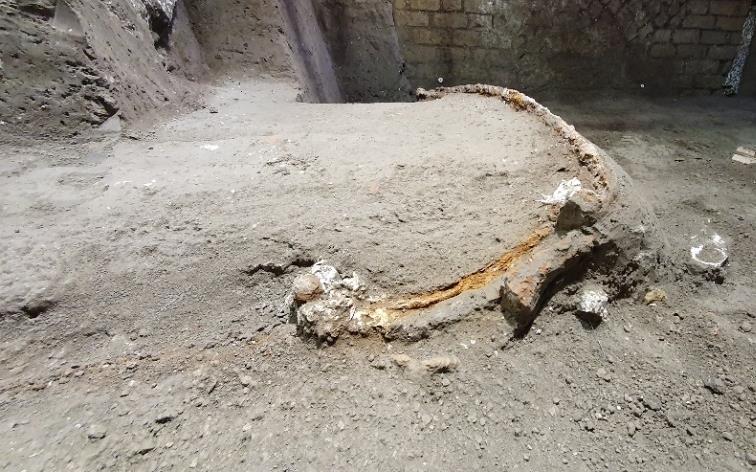
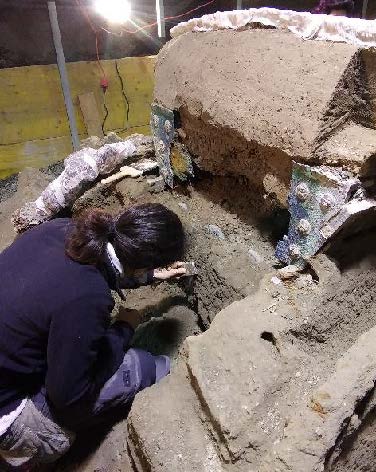
THE MICRO-EXCAVATION
From the moment it was identified, the excavation of the chariot has proved to be particularly complex due to the fragility of the materials involved and the difficult working conditions; as a result, it was necessary to proceed by means of a micro-excavation conducted by the restorers of the Park, who are specialised in the treatment of wood and metals. At the same time, whenever a void was discovered, plaster was poured in as part of an attempt to preserve the imprint of the organic material that was no longer present. Consequently, it has been possible to preserve the shaft and platform of the chariot, as well as the imprints of ropes, thus revealing the chariot in all of its complexity.
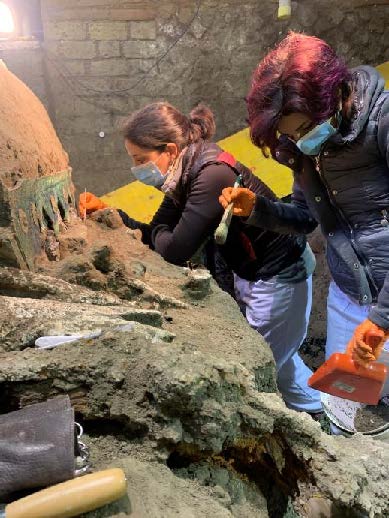
Given the extreme fragility of the chariot and the risk of possible illegal operations and damage caused by news leaks, the team has worked every weekend since mid-January, both to guarantee its conservation but also to send a strong signal of the Park’s action to protect the heritage, alongside the Public Prosecutor’s Office of Torre Annunziata and officers of the Naples Carabinieri Headquarters for the Protection of Cultural Heritage, assisted by investigators of the Carabinieri Group Command of Torre Annunziata. This collaboration also led to the participation of Park technicians in the ongoing trial of the alleged illegal excavators, who have struck this villa severely in recent years.
With the in situ micro-excavation completed, the various elements of the chariot have been transported to the laboratory of the Archaeological Park of Pompeii, where the restorers are working to complete the removal of volcanic material which still engulfs certain metal elements, and to begin the lengthy restoration and reconstruction of the chariot.
What has emerged has been systematically recorded via careful photographic documentation and through laser scanner surveying
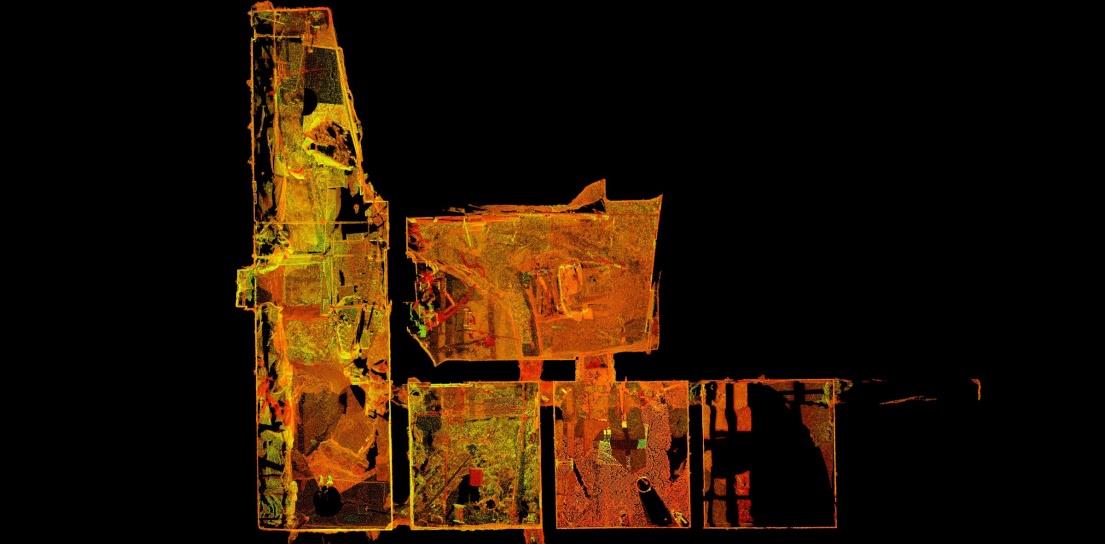

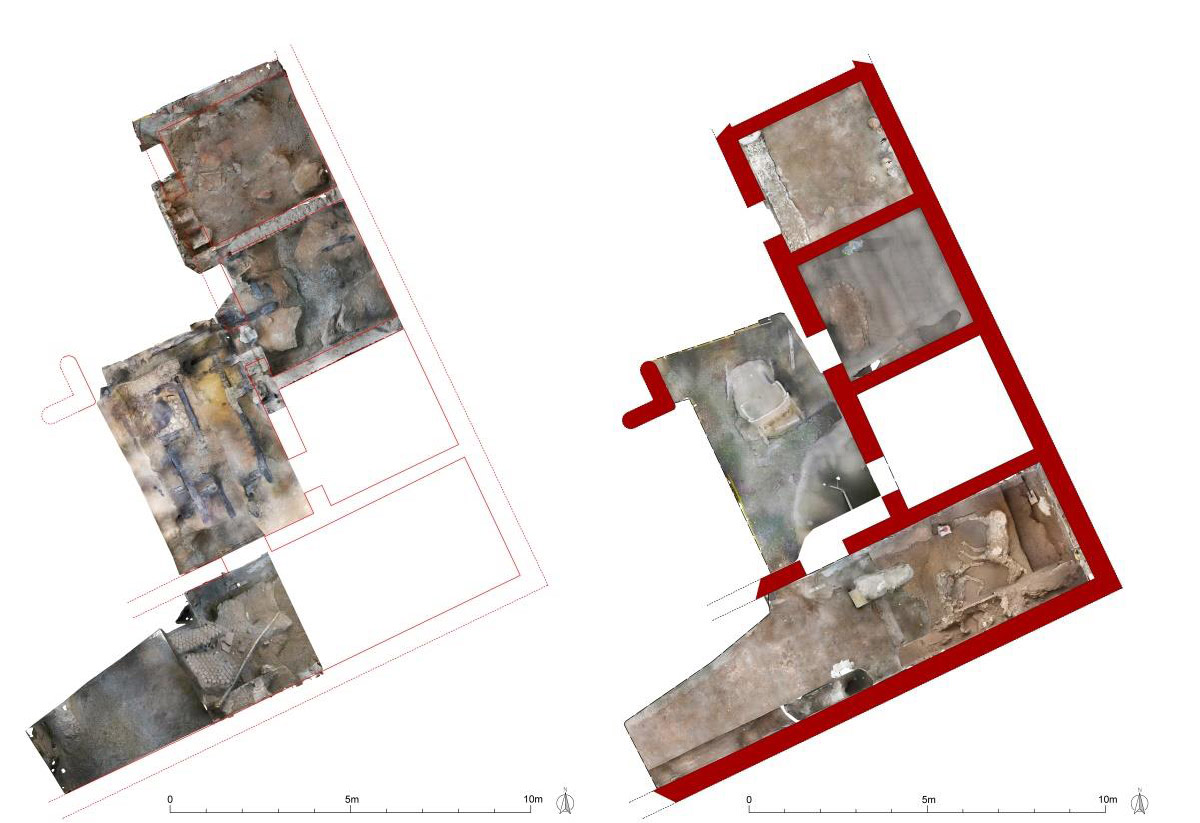
“Pompeii continues to amaze with all of its discoveries, and it will continue to do so for many years yet, with twenty hectares still to be excavated. But above all, it demonstrates that valorisation can occur, and tourists can be attracted from all over the world, whilst at the same time research, education and studies are being conducted, and a young director like Zuchtriegel will develop this commitment”. Thus commented the Minister of Culture Dario Franceschini on the discovery of the chariot in the excavations of Civita Giulia. “What has been announced today is a discovery of great scientific value. A round of applause and thanks to the Archaeological Park of Pompeii, the Public Prosecutor’s Office of Torre Annunziata and to the officers of the Carabinieri Headquarters for the Protection of Cultural Heritage for the collaboration which has averted the theft and illegal sale of these extraordinary finds on the black market”.
“It is an extraordinary discovery for the advancement of our knowledge of the ancient world”, declared Massimo Osanna, outgoing Director of the Archaeological Park, “At Pompeii vehicles used for transport have been found in the past, such as that of the House of Menander, or the two chariots discovered at Villa Arianna (one of which can be admired at the new Stabian Antiquarium), but nothing like the Civita Giuliana chariot.
What we have is a ceremonial chariot, probably the Pilentum referred to by some sources, which was employed not for everyday use or for agricultural transport, but to accompany community festivities, parades and processions. This type of chariot, which has never before emerged from Italian soil, bears comparison with finds uncovered around fifteen years ago inside a burial mound in Thrace (in northern Greece, near the Bulgarian border). One of the Thracian chariots is particularly similar to ours, even if it lacks the extraordinary figurative decorations that accompany the Pompeian find.
The scenes on the medallions which embellish the rear of the chariot refer to Eros (Satyrs and nymphs), while the numerous studs feature erotes. Considering that the ancient sources allude to the use of the Pilentum by priestesses and ladies, one cannot exclude the possibility that this could have been a chariot used for rituals relating to marriage, for leading the bride to her new household.
If the entire operation had not been initiated courtesy of the synergy with the Public Prosecutor’s Office of Torre Annunziata, with which a memorandum of understanding was signed in order to combat the criminal phenomena of looting archaeological sites and trafficking finds and works of art, we would have lost extraordinary testimonies which enhance our understanding of the ancient world”.
“In recent years the Public Prosecutor’s Office at the Court of Torre Annunziata has paid constant attention to the protection of the immense archaeological heritage present in our jurisdiction” – declared the Chief Prosecutor of Torre Annunziata, Nunzio Fragliasso
“The fight against the looting of archaeological sites, both inside and outside the urban area of ancient Pompeii, is certainly one of the primary objectives of the Office.
It is in this context that the memorandum signed by this Public Prosecutor’s Office in 2019 with the Archaeological Park of Pompeii is placed, which represents a ‘pilot agreement’ in the field of synergy between Institutions for safeguarding national artistic heritage.
The collaboration between the Public Prosecutor’s Office of Torre Annunziata and the Archaeological Park of Pompeii has proved itself to be a formidable instrument, not only for bringing finds of exceptional historical and artistic value to light, but also for halting the criminal actions of individuals who for years have been the protagonists in a systematic looting of the priceless archaeological heritage preserved in the vast area of the Civita Giuliana villa, which is still largely buried and to which the recent exceptional findings bear witness.
The criminal activities of which the Public Prosecutor’s Office of Torre Annunziata had been made aware, and which had to be fully confirmed - specifically the digging of a complex network of tunnels at a depth of over 5 metres, and the looting and partial destruction of illegally explored areas - required an investigative operation which could not have been carried out other than by a planned archaeological excavation, which was consequently conducted alongside the Archaeological Park of Pompeii.
The excavation operations carried out on the site by the Archaeological Park of Pompeii with the aid, for investigative purposes, of officers of the Carabinieri Headquarters for the Protection, under the constant coordination of Assistant Prosecutor Filippelli, made it possible to gather decisive and irrefutable evidence of serious and repeated incidents of the theft and trafficking of precious archaeological finds by ‘grave robbers’.
Among other things, it has been established that the very chariot which has now been unearthed had miraculously escaped the looting of grave robbers, despite being literally touched by the tunnels dug by the perpetrators at a depth of over 5 metres.
As we speak, the criminal trial against two defendants suspected of being the chief architects of the aforementioned criminal activity, whose dwelling still now stands on the site of a plundered Ancient Roman villa, is proceeding before the Court of Torre Annunziata.
The investigations have allowed us to ascertain that the network of over 80 metres of tunnels used for the systematic looting of the archaeological area originated at the property of the two defendants.
Over the coming years, the work of this Office in the protection of artistic, archaeological and cultural heritage of the area will be constant and will be given the highest priority, giving particular attention to the operation aimed at the recovery of precious archaeological finds which have been stolen and exported abroad, and their return”.
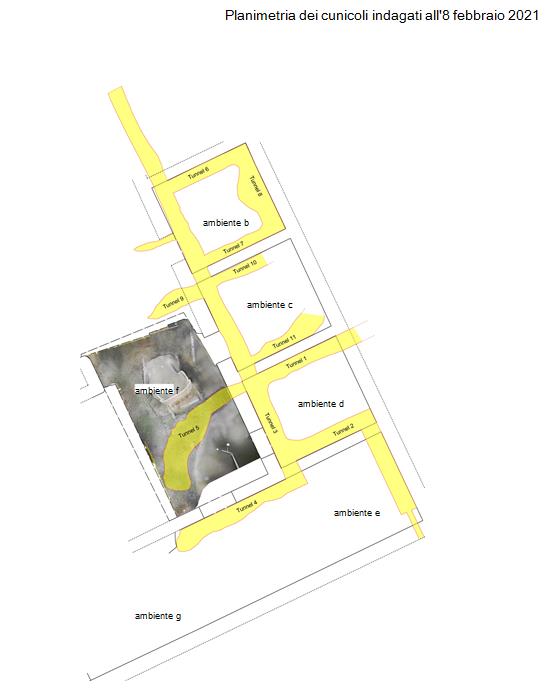
Location of the Civita Giuliana Villa to the north of Pompeii
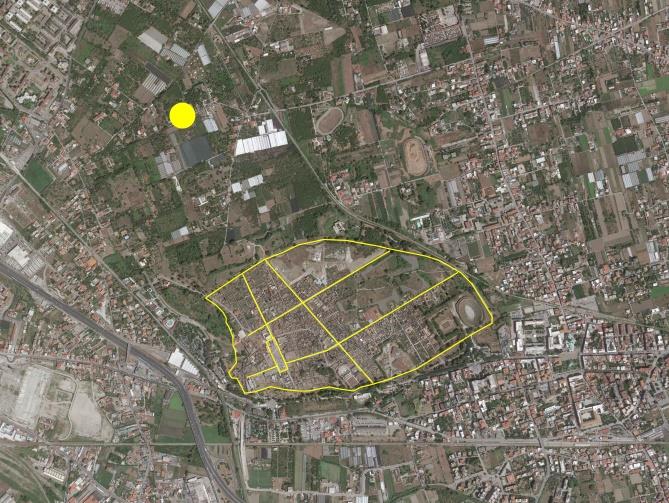
THE CHARIOT
The chariot was found inside a double-level portico which probably faced onto an uncovered courtyard, not far from the already-investigated stable, to which it was connected by a door.
The layer of cinerite which entombed the chariot had allowed the preservation of its original dimensions and of the individual parts which mark out the connected structure.
The artefact in question is a four-wheeled chariot which, on the basis of information recorded by sources and the few archaeological traces that have otherwise been found to date, can probably be identified as a pilentum, a transport vehicle used in the Roman world by the elites in ceremonial contexts.
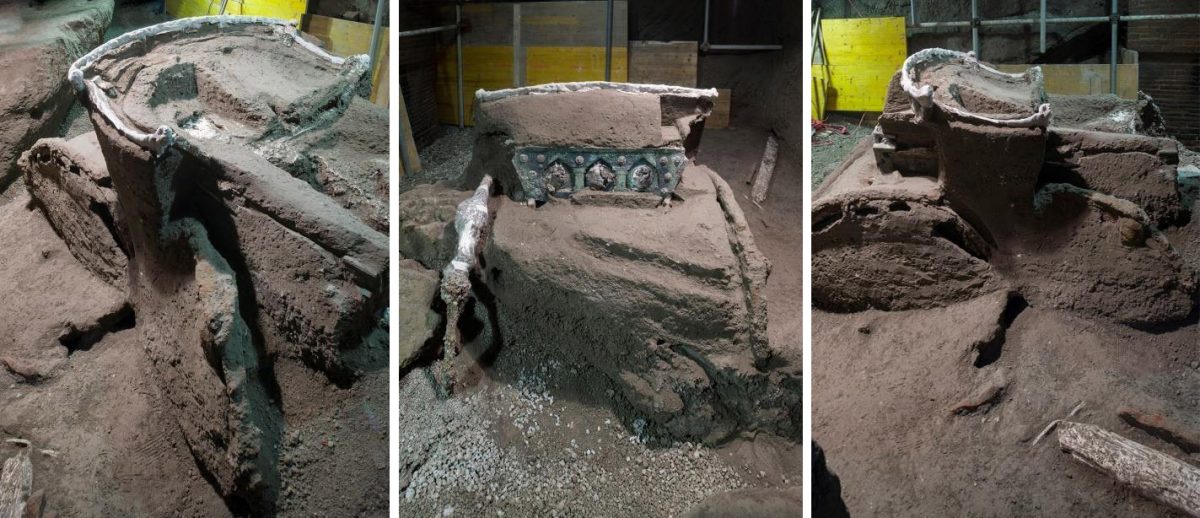
Atop high iron wheels, connected by an advanced mechanical system, rests the light carriage (0.90 x 1.40 m), or the main part of the chariot, where the seat was located, surrounded by metal arm and backrests, for either one or two individuals.
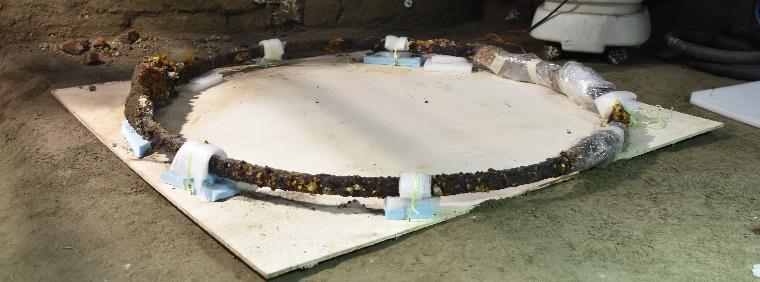
The carriage is richly decorated along both sides with alternating engraved bronze sheet and red and black painted wooden panels, whilst at the rear there is a complex and extensive decorative system featuring three distinct registers with a succession of bronze and tin medallions with figurative scenes.
These medallions, set in bronze sheet and surrounded by decorative motifs, represent male and female figures in relief, depicted in erotic scenes.
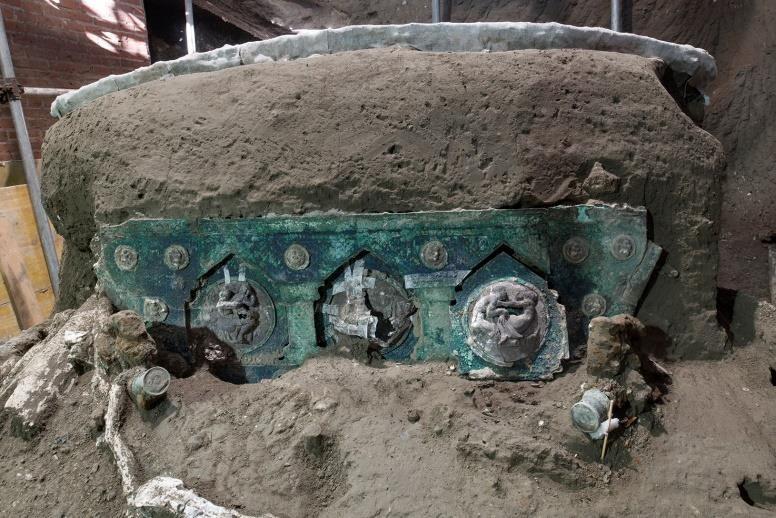
The bronze sheet is also decorated in its upper section with small medallions, also in tin, which depict cupids engaged in various activities. In the lower section of the chariot there is a small female herm in bronze with a crown.
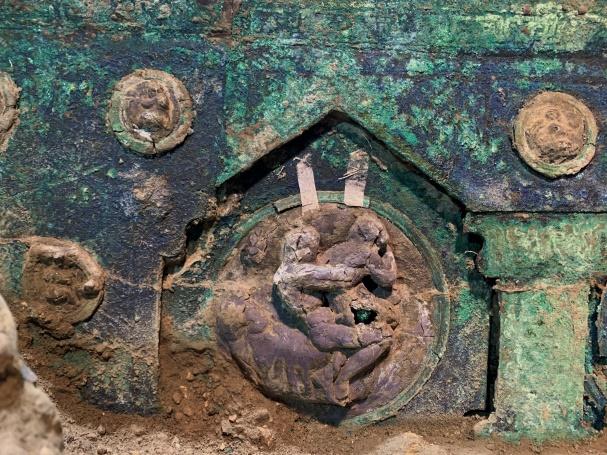
Archaeobotanical analyses were also conducted in this instance, which showed that the wood used to create the side structures and rear of the chariot, to which the bronze decorative elements were fixed with small nails and clamps, was beech, which is particularly suitable for this kind of production.
This kind of chariot is entirely unique in Italy, not only on account of its state of preservation, as we have not only individual decorations but the entire vehicle, but also because it is not a chariot used for the transport of agricultural products or the activities of daily life, as is already attested both at Pompeii and Stabiae.
We might recall that in the adjacent stable, which had already been investigated, it was possible to create casts not only of the trough, but also of a large horse, which bore a rich bronze harness.
In the same room two other horses were discovered, one lying on its right side and the other on its left, of which it was sadly not possible to make a cast as a result of the damage caused by the tunnels of the grave robbers, and subsequent overbuilding of the cavities, which destroyed the context of the discovery. Nevertheless, other bronze harness elements were recovered, relating to a saddle and other parade elements, which can certainly be connected to the newly discovered chariot.


